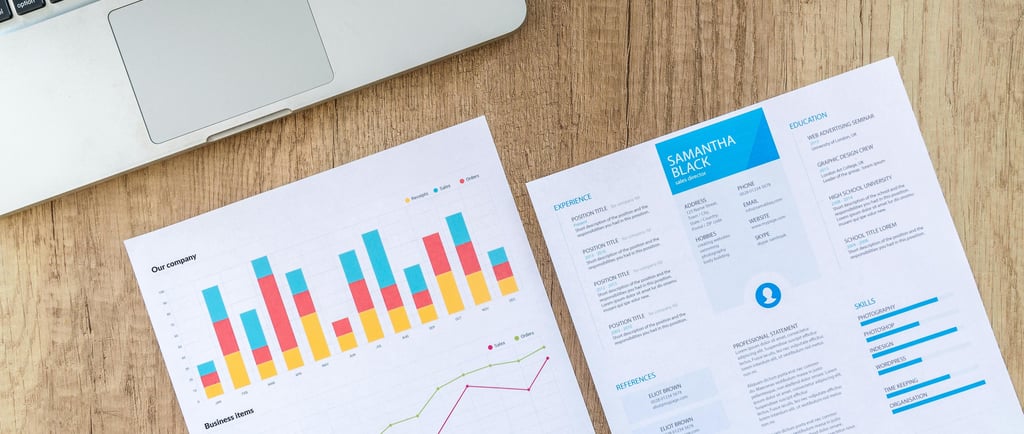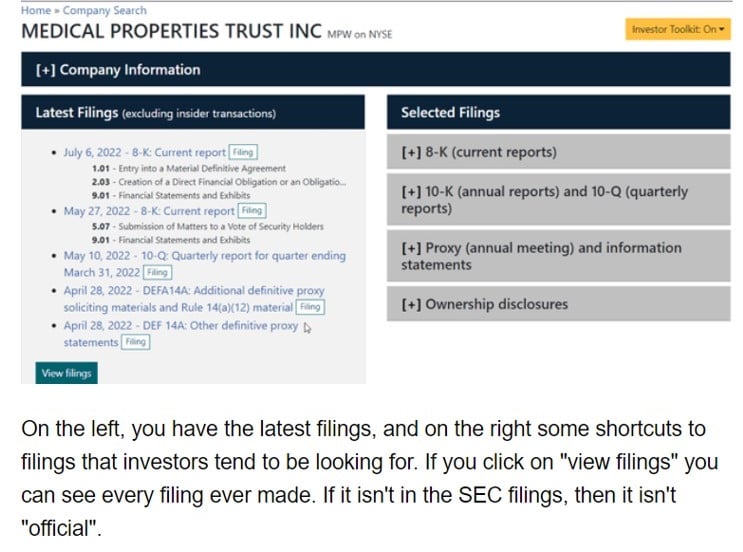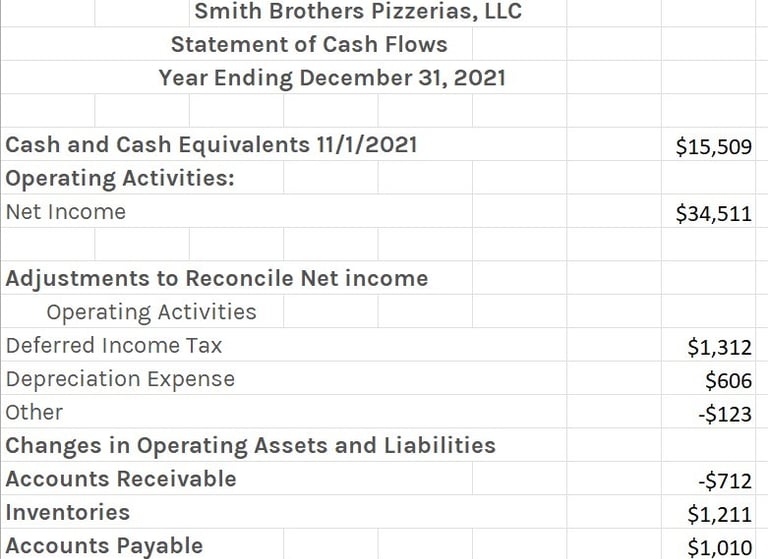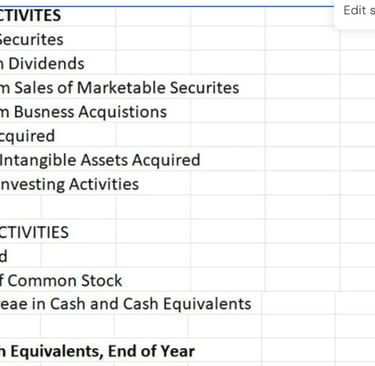How to Read Financial Statements - Part 3 - The Cashflow Statement
The cash flow statement is very important in analyzing the profitability of a company. The cash flow statement can reveal what phase a business is in: whether it’s a rapidly growing startup or a mature and profitable company. It also can reveal whether a company is going through a period of transition or a state of decline. By reviewing this information, an investor may determine that a company with uneven cash flow may be too unstable to consider the company a good investment.
David Parham
4/27/20248 min read


DISCLAIMER - I am not a Financial Advisor and do not work for any Brokerage Firm. The opinions given are my own and are not to be used as professional advice. These are my findings and can hopefully help you to make informed decisions on investing. Consult a Broker or Lawyer before making any investment.
How to Read Financial Statements - Part 3
The Cash Flow Statement
It is important to understand what we are buying when purchasing Stocks. The market can change overnight, so we best understand what we are purchasing and be sure the stocks are worth the value we are paying for them.
We began a four-part study on reading financial statements last week. If you have not read how to read the Balance Sheet and Income Statement, you can read those here:
Reading Financial Statements – Part 1 – The Balance Sheet
Reading Financial Statements – Part 2 – The Income Statement
Now if you have minimal investments or you mainly purchase Mutual Funds or full market ETFs, these articles will be of minimal help to you. However, if you are directing your own ROTH IRA investments and purchasing specific stocks or specific market ETFs (Exchange Traded Funds), these articles may benefit you. On ETFs, you can identify the top 10 or 20 investments in the ETF, and analyze the quarterly filings.
To properly be able to determine the company’s real value versus what it is being sold for, and see if a company is truly being managed well, takes a considerable amount of work. When I started this article, I intended to discuss it all in one article. However, after reviewing my accounting books and doing some online studies, it became clear that this is a very deep subject and will take a lot of time to cover successfully. We could spend 10 or 20 articles, but I don’t want to overly complicate the issues. So this week, our goal will be to learn how to understand the Cash Flow Statement.
Each quarter, companies traded on the New York Stock Exchange and the NASDAQ are required to file paperwork with the securities and exchange commission (SEC). These quarterly filings, called the 10-Q filings, can be located at SEC.gov. The yearly financial statements are also available, and these are labeled the 10-K The 10-K is of course a more comprehensive and also audited financial statement that is filed after the end of the company’s fiscal year.
Management may add some color and commentary to their yearly report. Some also provide supplements that provide additional details and sometimes give them in a more user-friendly format.
I am including this again as you must know how to obtain the various Financial statements at SEC.GOV. I included this in the balance sheet, but think it is important enough to mention it again. All financial statements can be obtained at this location.
Rida Morwa of Seeking Alpha did a blog on Reading Balance Sheets last month, and he mentioned that it is always important to realize that management in preparing these financial statements is inherently biased towards their companies. So while we may get a biased opinion, we can still review these statements and determine the true value of the company and whether they are worth the current stock price or if they might be selling at a discount.
To find the financial statements (10-Q and 10-K), go to the SEC.GOV website and use the EDGAR search page to locate the company you wish to review. You can type in the Stocks Ticker (IE IBM ) or type in the company name.
In Rida Morwa’s blog article, he searched one of my favorite stocks, MPW / Medical Properties Trust which is a Medical Reit. This is what appeared searching on MPW:


You would then click on the 10-K and 10-Q tab on the right to select the statements you want to review.
What is the Purpose of the Cash Flow Statement?
The purpose of the cash flow statement is to provide a detailed picture of what happened to a business’s cash during a specified period of time, known as the accounting period. It will match the time normally of the Income statement, consisting normally of either a quarter (3 months) or a full year, although monthly cash flow statements can be provided. It demonstrates the organization’s ability to operate in the short and long term, based on how much cash is flowing into and out of the business.
Cash flow statements are typically broken into three sections. Cash flow from operating activities, cash flow from investing activities, and cash flow from financing activities.
Normally the operating activities section needs the most study, as its where we see how the cash flowed from regular goods and services and shows us both the revenue and the expenses. The investing activity is cash flow from purchasing or selling assets, which are usually some form of physical property. (Real estate, vehicles, patents, etc.) Financing activities detail cash flow from debt and equity financing.
Note: There is a difference between cash flow and profit. While cash flow refers to the cash that is flowing into and out of a company, whereas profit refers to what remains after all of the company’s cash flowed in and out. Profit refers to what is remaining after all expenses have been deducted from its revenues. Both things are important.
With a cash flow statement, you see the types of activities that generate cash and it can be used to make financial decisions. (like whether this is a good company in which to invest your money.)
Cash from the operating income should routinely exceed net income because a positive cash flow speaks of a company’s financial stability and its ability to grow its operations. Having positive cash flow doe not necessarily mean the company is profitable. You need to examine the balance sheet and income statements for that decision.
As an investor, the cash flow statement can help you better understand whether this is a good business to invest your money. As a business owner, it can help you understand the performance of your company and allow you to adjust your business strategy. As an accountant or manager, you can become more effective in managing your team, and allow you to play a larger role in your company. Non-finance professionals can also understand the concepts behind a cash flow statement.
HOW CASH FLOW IS DETERMINED
There are two methods to do a cash flow statement.
1. The Direct Method
The direct method is based on the transactional information that impacted the cash during the specified period. In the direct method, you take all cash collections from operating activities and subtract all the cash disbursements from these same operating activities.
2. The In-Direct Method
The second way depends on the accrual accounting method in which the accountant records revenues and expenses at a time other than when cash was paid or received. This means that those accrual entries and adjustments cause the cash flow from operating activities to different from net income.
Instead of organizing transactional data like the direct method, the accountant starts with the net income number found from the income statement and makes adjustments to undo the impact of the accruals that were made during the period. In doing this method, the accountant identifies any non-cash expenses for the period from the income statement. The most common of these types of transactions involve depreciation. It reduces the values of the asset over time, and amortization allows spreading the payments over multiple periods.
HOW TO INTERPRET THE CASHFLOW STATEMENT
The cash flow statement can reveal what phase a business is in: whether it’s a rapidly growing startup or a mature and profitable company. It also can reveal whether a company is going through a period of transition or a state of decline.
By reviewing this information, an investor may determine that a company with uneven cash flow may be too unstable to consider the company a good investment. A department head may look at the same statement and determine how his department is impacting the health of the company. With it, adjustments can be made to increase profitability.
Cash flow is typically depicted as positive if the business is taking in more cash than it is spending. Likewise, if spending more than bringing in cash, it can be negative.
These examples depict a Positive Cash flow which is desirable or a Negative Cash flow which is normally a bad sign. Negative cash flow can be caused by expenditures that do not align with the income to be produced by those expenses.
Negative cash flow can also be caused by a company’s decision to expand the business and invest in future growth.
Cash Flow Statement Example (Fictional Company)




From the cash flow statement above, we see the three breakouts of the money that was brought in from the activities of the company. The first section shows that the company brought in a net of $37,980.
Investing Income for the year was: $581, while the net of financing and debt was $6732. The three of these made the total year increase of $45,203 which increased cash from the beginning of the year which was $15,509 to a new high of $60,712. All of these indicators are positive as far as cash flow is involved. Increasing your net cash by 3 times the start of the year is a positive cash flow position.
The Cash Flow Statement if one of the most critical financial documents prepared by the business. It offers valuable information as to whether the company is showing an increase or a decrease (Negative cash flow) which helps you in investing to decide if the company is moving in a good direction.
Pay particular attention to the Cash Flow Statement and also to the profitability of the company based on the Income Statement. As mentioned in the part 1 article, the net assets give you an indication as to the true value of a stock in regards to being too high or if a lower value meaning it could be purchased below the Net Asset Value.
We will conclude our study on reading financial statements next week when we cover the last of the 4 parts which is to read the Statement of Retained Earnings.
L
Internet Direct Laptopsof All Investment Articles
List of All Minimalism Articles
Internet Direct Laptops






Contact
davidparham@lifecanbesimple.net
Follow
Connect with Us
+1 940-730-5105